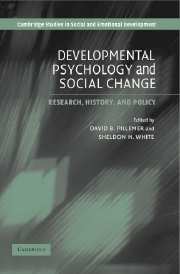Book contents
- Frontmatter
- Contents
- Preface
- List of Contributors
- Introduction: What Kind of Science Is Developmental Psychology?
- Part One The Developing Child: Global and Historical Perspectives
- Part Two Designing Child and Family Policies
- Part Three Designing Child Health Policies
- Part Four Designing Effective Learning Environments for Children and Adolescents
- 9 A Cultural/Historical View of Schooling in Human Development
- 10 The Rise of the American Nursery School: Laboratory for a Science of Child Development
- 11 Actualizing Potentials: Learning through Psychology's Recurrent Crises
- 12 The Rise of a Right-Wing Culture among German Youth: The Effects of Social Transformation, Identity Construction, and Context
- 13 Learning Potential Assessment: Where Is the Paradigm Shift?
- 14 Teaching as a Natural Cognitive Ability: Implications for Classroom Practice and Teacher Education
- Index
- References
10 - The Rise of the American Nursery School: Laboratory for a Science of Child Development
Published online by Cambridge University Press: 03 December 2009
- Frontmatter
- Contents
- Preface
- List of Contributors
- Introduction: What Kind of Science Is Developmental Psychology?
- Part One The Developing Child: Global and Historical Perspectives
- Part Two Designing Child and Family Policies
- Part Three Designing Child Health Policies
- Part Four Designing Effective Learning Environments for Children and Adolescents
- 9 A Cultural/Historical View of Schooling in Human Development
- 10 The Rise of the American Nursery School: Laboratory for a Science of Child Development
- 11 Actualizing Potentials: Learning through Psychology's Recurrent Crises
- 12 The Rise of a Right-Wing Culture among German Youth: The Effects of Social Transformation, Identity Construction, and Context
- 13 Learning Potential Assessment: Where Is the Paradigm Shift?
- 14 Teaching as a Natural Cognitive Ability: Implications for Classroom Practice and Teacher Education
- Index
- References
Summary
American nursery schools served both as laboratories for the derivation of a science of child development and as consumers of this new science. Nursery schools grew out of the larger preschool movement of eighteenth- and nineteenth-century infant schools and kindergartens and from new conceptions of childhood. Treatises on how to educate young children, medical advice and child rearing manuals, Darwin's theory of evolution, and other early work in biology and comparative psychology laid the groundwork for the study of child development. G. Stanley Hall's child study movement of the 1890s was the main precursor. Edward L. Thorndike's educational psychology added new quantitative methodology. All of this came together in the environment of the nursery school, where psychologists, teachers, and parents sought new scientific information about children, and young children were readily available for research (Beatty, 1995; Koops & Zuckerman, 2003; Sears, 1975; Smuts and Boardman, 1986; White, 2003).
Driven by societal needs and concern for children's well-being, the nursery-school movement and child development research were based on the belief that scientific knowledge about young children, child rearing, and preschool education could ameliorate larger social problems. The flood of immigrants and increasing industrialization, urbanization, and poverty heightened existing worries about child welfare. The growth of cadres of experts in the sciences, social sciences, and children's professions created a new infrastructure. The roaring economy and more organized private charities and government agencies provided financial and political support.
- Type
- Chapter
- Information
- Developmental Psychology and Social ChangeResearch, History and Policy, pp. 264 - 287Publisher: Cambridge University PressPrint publication year: 2005
References
- 3
- Cited by



